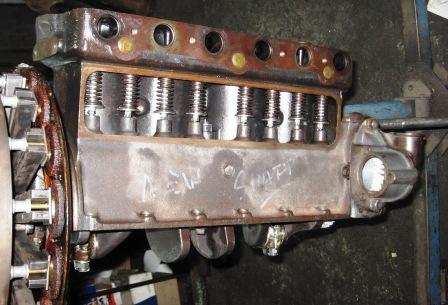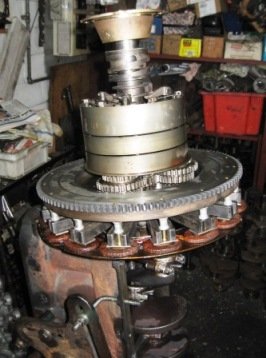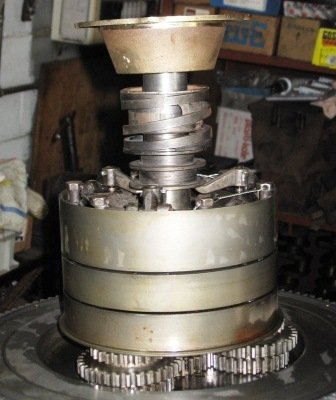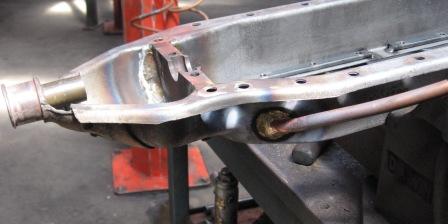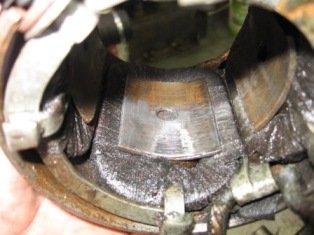|
My Model T Fordbreaks her crank.The rebuild nears completion...
As you saw on the previous page, my Model T Ford engine rebuild is progressing well. With the bottom end of the engine assembled, the valve gear, including adjustable tappets have been fitted also.
With this all complete, the coil plate, magneto assembly and flywheel were fitted and clearances set, we moved onto fitting the transmission.
In my case, the output shaft of the transmission (the driven plate) was showing some signs of rough wear where the clutch spring is fitted. Not uncommon, but we also discovered, that in this case, someone had previously turned the shaft down in a lathe, reducing the overall diameter. As we had decided to fit a modern bearing 4th rear main, we soon discovered that the altered shaft dimension required more than a standard bearing, so the new bearing assembly was changed and altered to fit the cleaned up driven plate shaft. You can see the 4th main bearing (in the brass housing) sitting, but not fitted, on the end of the shaft in the photo. The fitment of this bearing is crucial to the longevity of the engine as it must be accurately aligned when the engine sump/pan is fitted, ensuring there is no strain place on the crankshaft and that the transmission assembly is correctly supported.
One of the last decisions to be made (other than what colour the engine will or should be painted) was the fitting of an external oil line. I had previously fitted an accessory oil line from the magneto pick up, but found this to be a fairly small diameter, so have opted for a 'DIY' solution. Here, a larger diameter copper line is drilled and then brazed into the transmission pan, right at the front in before the number one cylinder dipper. When finished, the other end is run along the block and drilled and tapped into the hogshead, separate from the magneto pick up. (not yet shown)
As the end of the rebuild fast approaches, the final stages of the main engine work were to reunite the sump and hogshead with the block. As I have chosen to try the Guinn Wooden transmission bands the bands must be fitted with the hogshead off. During a rebuild, irrespective of which band choice you make, fitting them at this stage makes a fiddly job a breeze as you have full access. Although, connecting the bands up to the pedal shafts still requires some knack as this obviously needs the hogshead in place. Wooden and hard bands will not tolerate any flexing of the band steel and therefore, cannot be fed around the transmission drums when the hogshead is in place.
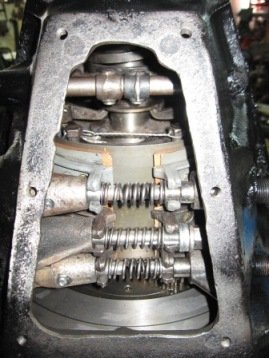
When it came to choosing an enigne colour, I did a bit of research to come up with some fairly inconclusive results.
Previous research of the Ford archives showed that late Model T Ford engines were painted dark green, but, there are also indications that some engines were painted black, some grey and some even left as bare cast iron. I'm not a complete purist, but do like some things to be accurate. In this case, I didn't feel that dark green would 'go' with the burgundy colour of the car (which isn't an original colour) so, was tempted to choose grey, as this was the colour the engine was when I got the car. I had a 'moment' and remembered how put off I was seeing the inevitable oil leaks on the old grey engine, so chose to go oil leak friendly black.
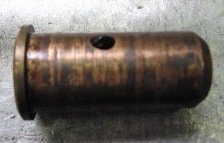
For more starter motor information, come back soon when we'll add a technical page dedicated to the Model T Ford starter motor.
Come back soon to read up on the final stages of assembly, the refitting of the power train to the car and the initial fire up of the new engine. Click here to go back to page 1 of the Model T Ford rebuild
Click here to return to Model T Ford Technical page
|
